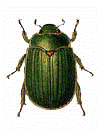Museum, University of Nebraska State
Document Type
Article
Date of this Version
1-8-2021
Citation
Larson, N.R.; O’Neal, S.T.; Kuhar, T.P.; Bernier, U.R.; Bloomquist, J.R.; Anderson, T.D. Heterocyclic Amine-Induced Feeding Deterrence and Antennal Response of Honey Bees. Insects 2021, 12, 69. https:// doi.org/10.3390/insects12010069
Abstract
The productivity and survival of managed honey bee colonies is negatively impacted by a diverse array of interacting factors, including exposure to agrochemicals, such as pesticides. This study investigated the use of volatile heterocyclic amine (HCA) compounds as potential short term repellents that could be employed as feeding deterrents to reduce the exposure of bees to pesticide-treated plants. Parent and substituted HCAs were screened for efficacy relative to the repellent N,N-diethyl-meta-toluamide (DEET) in laboratory and field experiments. Additionally, electroantennogram (EAG) recordings were conducted to determine the level of antennal response in bees. In video-tracking recordings, bees were observed to spend significantly less time with an HCA-treated food source than an untreated source. In a high-tunnel experiment, the HCA piperidine was incorporated in a feeding station and found to significantly reduce bee visitations relative to an untreated feeder. In field experiments, bee visitations were significantly reduced on melon flowers (Cucumis melo L.) and flowering knapweed (Centaurea stoebe L.) that were sprayed with a piperidine solution, relative to untreated plants. In EAG recordings, the HCAs elicited antennal responses that were significantly different from control or vehicle responses. Overall, this study provides evidence that HCAs can deter individual bees from food sources and suggests that this deterrence may not be the result of antennal olfactory detection. These findings warrant further study into structure–activity relationships that could lead to the development of short-term repellent compounds that are effective deterrents to reduce the contact of bees to pesticide-treated plants.



Comments
CC-BY